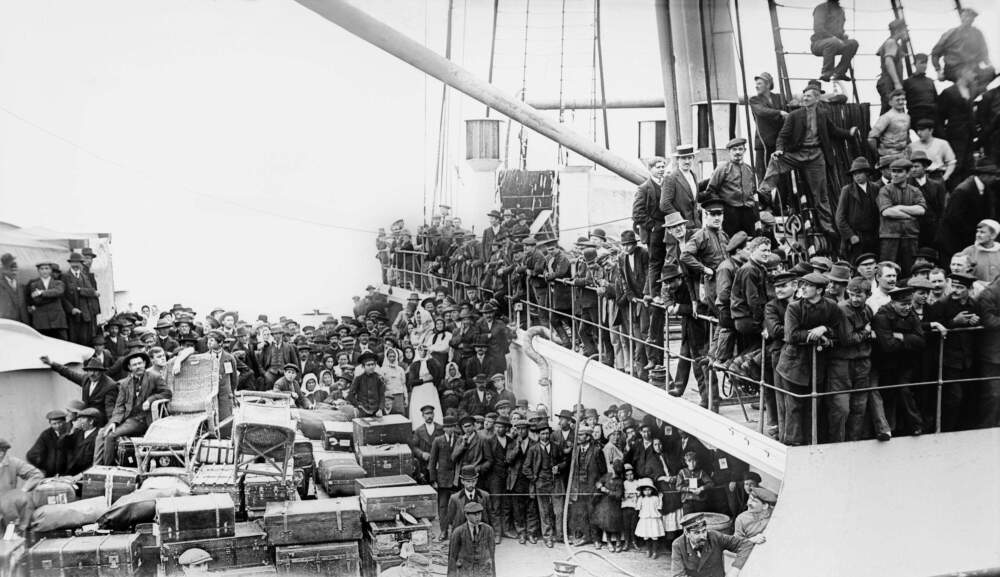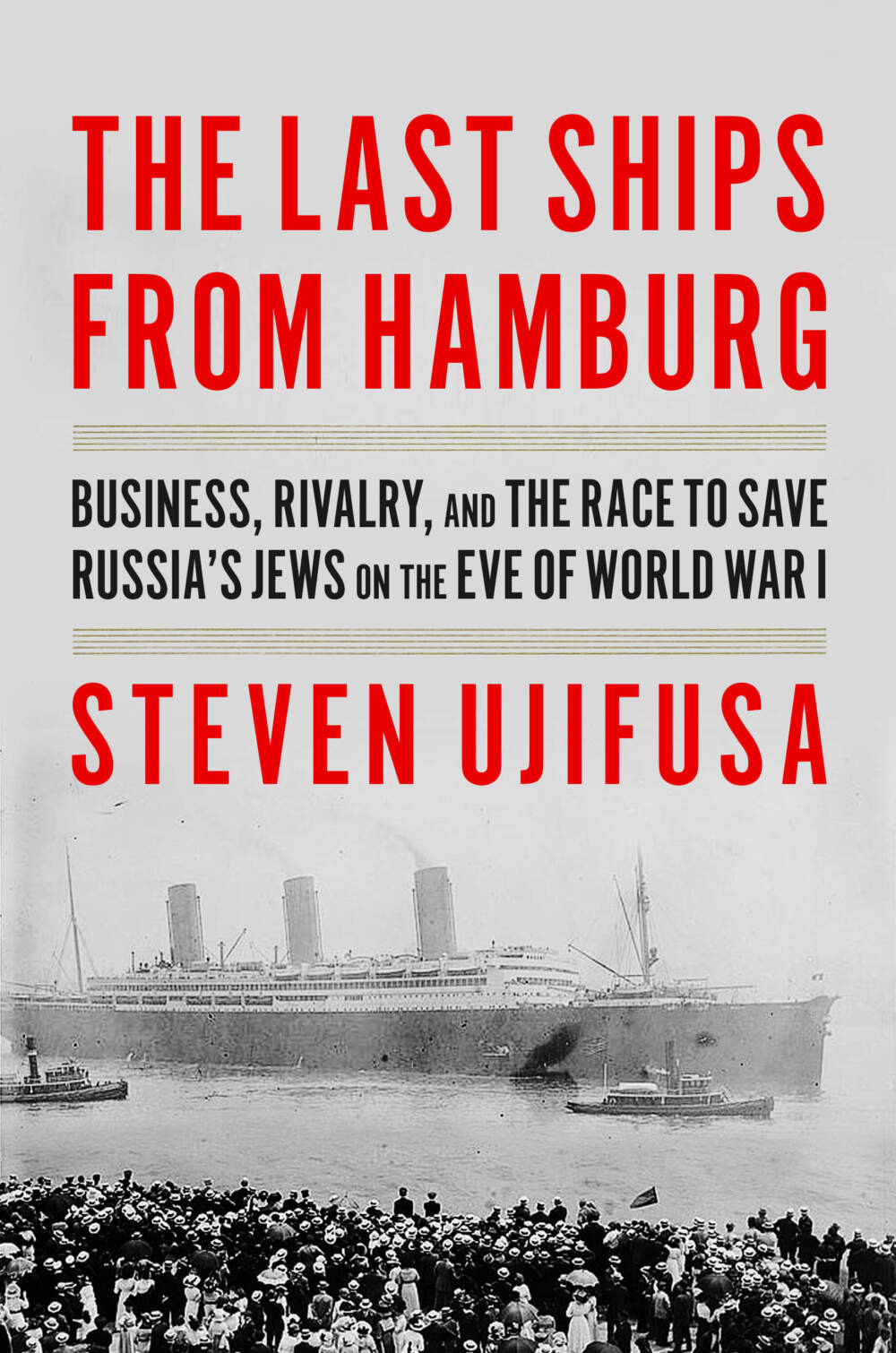Advertisement
'The Last Ships from Hamburg' tells story of Jewish immigration at turn of 20th century
Resume
From 1890 to 1921, 2.5 million Jews fleeing anti-semitic violence in Eastern Europe came to the United States aided by three businessmen including German-Jewish shipping magnate Albert Ballin.
Author Steven Ujifusa tells the story in the book "The Last Ships from Hamburg: Business, Rivalry, and the Race to Save Russia's Jews on the Eve of World War I." Ujifusa joins host Scott Tong to talk about the book.

Book excerpt: 'The Last Ships from Hamburg'
By Steven Ujifusa
Introduction
Between 1881 and 1914, over ten million people crossed the Atlan- tic from Europe to America, the largest mass migration of people from one continent to another in human history. Over 2.5 million of them were Jews from Central and Eastern Europe. Most of them were from the Russian Empire. While many European nations relaxed their ancient restrictions on Jews, Russia did the opposite. Jews were faced with a difficult decision: survive in menacing circumstances, convert to Christianity, or leave everything behind for a chance at a better life in a distant place.
Many chose to travel to America. During this thirty-three-year period, the industrializing United States had a largely unrestricted immigration policy. American business enterprises wanted cheap labor, and new arriv- als provided it in abundance. The Russian Empire, however, did not eas- ily permit its subjects to leave its confines. For most Jewish immigrants, their escape meant at least one illegal border crossing in order to get to the great seaports of Hamburg, Bremen, Liverpool, Antwerp, and Le Havre, where ships took them to America.
It was a journey fraught with anxiety and peril, but for the steamship lines and the international investment banks backing them, the mass im- migration across the Atlantic was a financial bonanza.
Three titans made this mass exodus of humanity logistically possible. Albert Ballin, managing director of the Hamburg-America Line (also known as HAPAG), created a transportation network that allowed Jews to travel seamlessly from Russia to America by train and steamship. Jacob Schiff, managing partner of the investment bank Kuhn, Loeb & Co., used his immense wealth to encourage and to help Jews to leave Russia for a fresh start in America. J. P. Morgan, mastermind of the International Mercantile Marine (IMM) trust, tried to take over the lucrative transat- lantic steamship business that Albert Ballin had created, aiming to run it in the same ruthless way he ran his banks and railroads.
In her 1882 ode to the Statue of Liberty, the poet Emma Lazarus called New York Harbor the “golden door” to America. But the immigration gateway slammed shut in 1914, when Europe became a battleground and all movement between nations, with the exception of armies, ground to a halt. Russia’s remaining Jews were trapped in a maelstrom of violence, war, and revolution. The German transatlantic steamship companies col- lapsed, and with them the intricate transportation networks that allowed Jews to escape to America.
By 1923, the American public had become first uneasy and then fright- ened by unrestricted immigration, and Congress passed a series of dis- criminatory laws that barred almost all new arrivals from Southern and Eastern Europe. It was a victory for a small group of socially elite racists in Boston and New York who felt that Jews and Italians were polluting the genetic makeup of the United States with supposedly inferior stock. Their racial theories, presumed to be scientific, mirrored the Nazi Party’s racial policies toward Jews that would culminate in Hitler’s Final Solu- tion a few years later.
Those who made it across the North Atlantic faced privation and pov- erty upon their arrival in America. Some did not last a generation, victims of industrial accidents, disease, or despair. Those who survived created new lives for themselves and their children, and breathed new energy into the American economy and culture. Among the Jewish immigrants were Supreme Court justice Felix Frankfurter, songwriter Irving Berlin, art- ist Mark Rothko, journalist Abraham Cahan, and labor organizer Emma Goldman. Children of immigrants included composers Leonard Bern- stein and Aaron Copland, Hollywood mogul Louis B. Mayer, and actress Lauren Bacall. Tens of thousands became doctors, lawyers, bankers, pro- fessors, teachers, and owners of businesses large and small. Most of them achieved success, material and otherwise, that their grandparents in the shtetls of Russia could have never imagined.
These three powerful personalities—Albert Ballin and Jacob Schif, Jews themselves, and J. P. Morgan—were all driven by very different motives, but the convergence of their ambitions helped make the Second Exodus a reality for millions of people. They did not survive to see the world they helped create, but their impact resonates to this day.
This is their story.
Excerpted from THE LAST SHIPS FROM HAMBURG Copyright © 2023 by Steven Ujifusa. Reprinted here with permission of Harper, an imprint of HarperCollins Publishers
This segment aired on February 15, 2024.